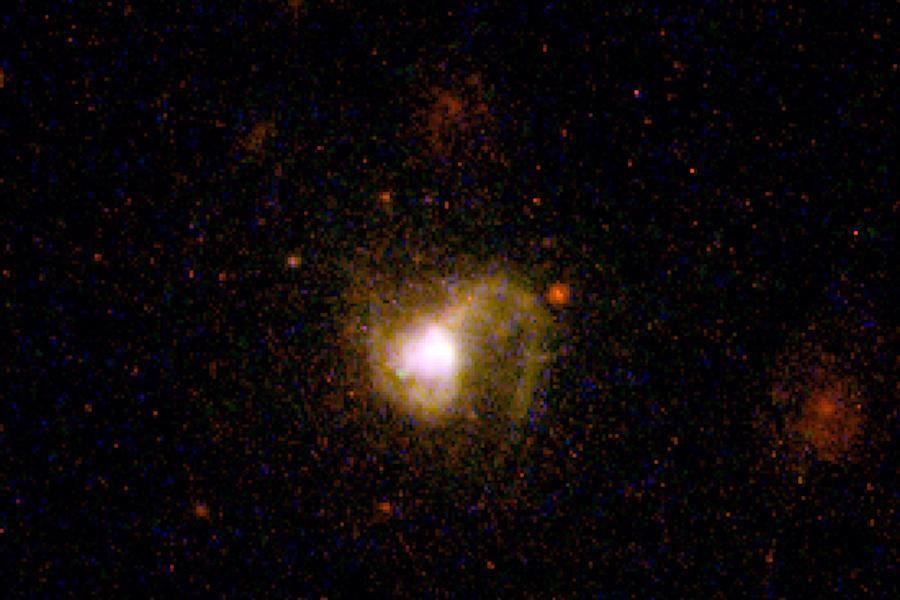Apr 30 2021
Astrophysicists from the University of Minnesota have demonstrated in a new study that high-energy light from small galaxies may have had a crucial role in the early evolution of the Universe.
 The University of Minnesota study shows that high-energy light from small galaxies, like the Pox 186 galaxy depicted above, may have played a key role in the reionization and evolution of the Universe. Image Credit: Podevin, J.f., 2006.
The University of Minnesota study shows that high-energy light from small galaxies, like the Pox 186 galaxy depicted above, may have played a key role in the reionization and evolution of the Universe. Image Credit: Podevin, J.f., 2006.
The study offers an understanding of how the Universe turned reionized, a problem that astronomers have been attempting to solve for several years. The study was published in The Astrophysical Journal, a peer-reviewed scientific journal of astrophysics and astronomy.
When the Universe evolved billions of years ago following the Big Bang, it was in an ionized state. That is, the protons and electrons floated freely across space. With the expansion and cooling down of the Universe, it transformed into a neutral state where the electrons and protons combined into atoms, similar to the condensation of water vapor into a cloud.
But scientists have now observed that the Universe is changing back to an ionized state. A key venture in astronomy is to find how this occurred. Astronomers have proposed that the energy for reionization must have been contributed by the galaxies themselves.
However, it is highly challenging for sufficient high-energy light to leave a galaxy because of hydrogen clouds inside it that absorb the light, quite similar to how clouds in the Earth’s atmosphere absorb sunlight on a cloudy day.
Astrophysicists at the Minnesota Institute for Astrophysics of the University of Minnesota’s College of Science and Engineering may have arrived at a solution for that problem.
The researchers used data from the Gemini telescope and observed the first-ever galaxy in a “blow-away” state, which implies that the hydrogen clouds have been eliminated, enabling the high-energy light to escape. They suspect that several supernovae, or dying stars, which exploded in a short time contributed to the blow-away.
The star-formation can be thought of as blowing up the balloon. If, however, the star-formation was more intense, then there would be a rupture or hole made in the surface of the balloon to let out some of that energy. In the case of this galaxy, the star-formation was so powerful that the balloon was torn to pieces, completely blown-away.
Nathan Eggen, Study Lead Author, University of Minnesota
Eggen recently received his master’s degree in astrophysics from the University of Minnesota.
Named Pox 186, the galaxy is so small that it can be fit within the Milky Way. The astronomers doubt that its small size, together with its huge population of stars—amounting to a hundred thousand times the mass of the Sun—enabled the blow-away.
The discovery confirms that a blow-away is viable, adding to the concept that small galaxies were mainly responsible for the reionization of the Universe and offering additional insights into how the Universe evolved how it is today.
There are a lot of scenarios in science where you theorize that something should be the case, and you don’t actually find it. So, getting the observational confirmation that this sort of thing can happen is really important. If this one scenario is possible, then that means that there are other galaxies that also existed in blow-away states in the past.
Nathan Eggen, Study Lead Author, University of Minnesota
“Understanding the consequences of this blow-away gives direct insight into the impacts similar blow-aways would have had during the process of reionization,” added Eggen.
Apart from Eggen, the astrophysicist group included Claudia Scarlata and Evan Skillman, both professors in the School of Physics and Astronomy at the University of Minnesota, and Anne Jaskot, an assistant professor of astronomy at Williams College.
The study was financially supported by grants from the University of Minnesota and NASA. The astrophysicists used the NASA/IPAC Extragalactic Database (NED) and NASA’s Astrophysical Data System.
Journal Reference:
Eggen, N. R, et al. (2021) Blow-away in the Extreme Low-mass Starburst Galaxy Pox 186. The Astrophysical Journal. doi.org//10.3847/1538-4357/abe85d.